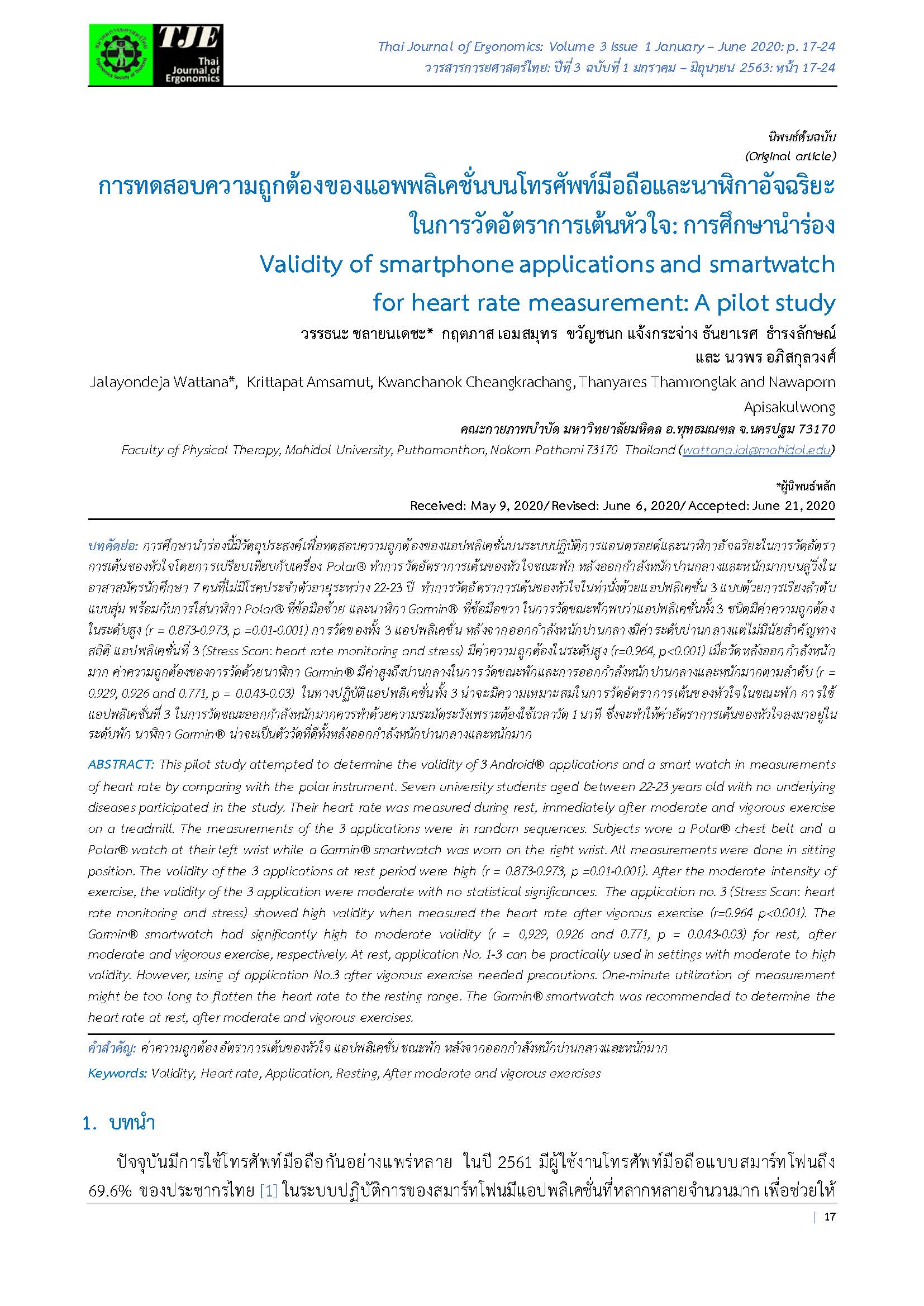Validity of smartphone applications and smartwatch for heart rate measurement: A pilot study
Main Article Content
Abstract
This pilot study attempted to determine the validity of 3 Android® applications and a smart watch in measurements of heart rate by comparing with the polar instrument. Seven university students aged between 22-23 years old with no underlying diseases participated in the study. Their heart rate was measured during rest, immediately after moderate and vigorous exercise on a treadmill. The measurements of the 3 applications were in random sequences. Subjects wore a Polar® chest belt and a Polar® watch at their left wrist while a Garmin® smartwatch was worn on the right wrist. All measurements were done in sitting position. The validity of the 3 applications at rest period were high (r = 0.873-0.973, p =0.01-0.001). After the moderate intensity of exercise, the validity of the 3 application were moderate with no statistical significances. The application no. 3 (Stress Scan: heart rate monitoring and stress) showed high validity when measured the heart rate after vigorous exercise (r=0.964 p<0.001). The Garmin® smartwatch had significantly high to moderate validity (r = 0,929, 0.926 and 0.771, p = 0.0.43-0.03) for rest, after moderate and vigorous exercise, respectively. At rest, application No. 1-3 can be practically used in settings with moderate to high validity. However, using of application No.3 after vigorous exercise needed precautions. One-minute utilization of measurement might be too long to flatten the heart rate to the resting range. The Garmin® smartwatch was recommended to determine the heart rate at rest, after moderate and vigorous exercises.
Article Details

This work is licensed under a Creative Commons Attribution-NonCommercial-NoDerivatives 4.0 International License.
References
สำนักงานสภานโยบายการอุดมศึกษา. สถิติเทคโนโลยีสารสนเทศและการสื่อสาร [Available from: http://stiic.sti.or.th/stat/ind-it/it-t012/.]
Guede-Fernández F, Ferrer-Mileo V, Mateu-Mateus M, Ramos-Castro J, García-González MÁ, Fernández-Chimeno M. A photoplethysmography smartphone-based method for heart rate variability assessment: device model and breathing influences. Biomedical Signal Processing and Control. 2020;57.
Engström E, Ottosson E, Wohlfart B, Grundström N, Wisén A. Comparison of heart rate measured by Polar RS400 and ECG, validity and repeatability. Advances in Physiotherapy. 2012;14(3):115-22.
Slydroid D. Heart Rate Monitor - HR Tracker - Pulse Checker [cited 2020 May]. Available from: https://play.google.com/store/apps/details?id=com.slydroid.heartratecam&hl=en.
MacroPinch. โปรแกรมตรวจวัดการเต้นของหัวใจ 2020 [Available from: https://play.google.com/store/apps/details?id=com.macropinch.hydra.android&hl=th.]
DUMSCO I. StressScan: heart rate monitoring and stress test v1.2.9.5 [cited 2020 May]. Available from: https://apkpure.com/developer/DUMSCO%2C%20Inc.
Mitchell K, Graff M, Hedt C, Simmons J. Reliability and validity of a smartphone pulse rate application for the assessment of resting and elevated pulse rate. Physiother Theory Pract. 2016;32(6):494-9.
De Ridder B, Van Rompaey B, Kampen JK, Haine S, Dilles T. Smartphone Apps Using Photoplethysmography for Heart Rate Monitoring: Meta-Analysis. JMIR Cardio. 2018;2(1):e4
Reddy RK, Pooni R, Zaharieva DP, Senf B, El Youssef J, Dassau E, et al. Accuracy of Wrist-Worn Activity Monitors During Common Daily Physical Activities and Types of Structured Exercise: Evaluation Study. JMIR Mhealth Uhealth. 2018;6(12):e10338-e.


